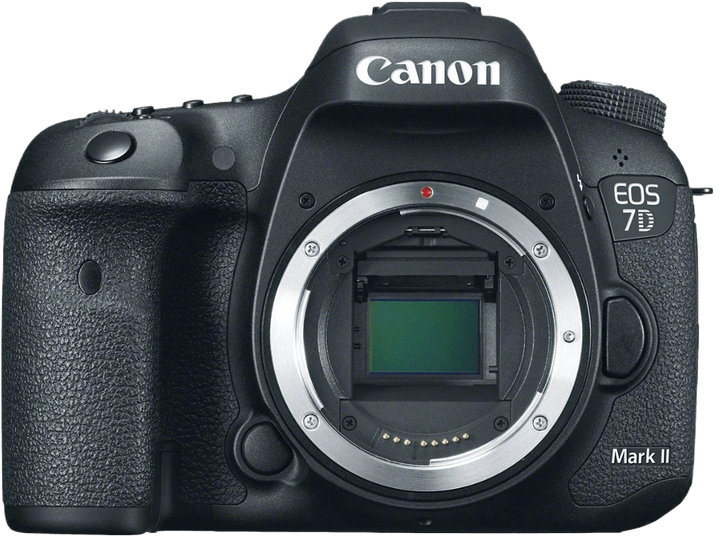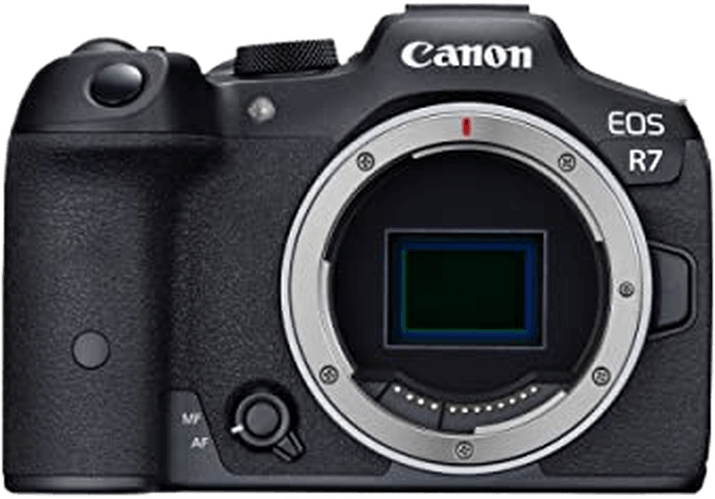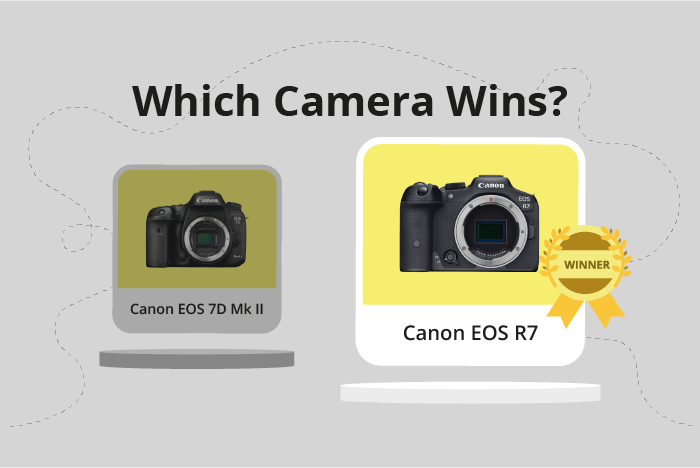Canon EOS 7D Mark II vs EOS R7 Comparison
Canon EOS 7D Mark II

Canon EOS R7

The Canon EOS R7 outperforms the Canon EOS 7D Mark II with a score of 83/100 compared to 60/100. Both cameras share similarities such as being part of the Canon EOS lineup and having interchangeable lenses. However, the EOS R7 is a mirrorless camera, while the 7D Mark II is a DSLR.
The EOS R7 boasts a more compact and lighter design, measuring 132 x 90 x 92mm and weighing 612g. Additionally, it offers a lower launch price of $1500 compared to the 7D Mark II’s $1800.
The 7D Mark II, released in 2014, is an older model but still offers quality performance. Its main advantage over the EOS R7 is its familiar DSLR design, which some photographers might prefer.
Considering the specifications, the Canon EOS R7 offers better value and performance, making it a more attractive option. The 7D Mark II might appeal to those who prefer a DSLR camera, but the EOS R7’s higher score, compact design, and lower price make it the winner in this comparison.
Canon EOS 7D Mark II vs EOS R7 Overview and Optics
The Canon EOS R7 triumphs over the Canon EOS 7D Mark II in optics, scoring 82 out of 100 compared to the 7D Mark II’s 61. Both cameras share some specifications, including a CMOS sensor type, an APS-C sensor size, and the same shooting speed of 10 frames per second. However, the EOS R7 outshines its counterpart in several aspects.
The EOS R7 features a higher megapixel count at 33, compared to the 7D Mark II’s 20.2, resulting in more detailed images. Its more advanced Digic X processor also contributes to better image quality and faster processing speeds. The EOS R7 boasts a significantly higher DXOMARK sensor score of 97, compared to the 7D Mark II’s 70, showcasing its superior sensor performance. Furthermore, the EOS R7 has a Canon RF lens mount, offering compatibility with the latest Canon lenses. The camera also includes image stabilization, which the 7D Mark II lacks, allowing for sharper images and steadier video footage.
On the other hand, the Canon EOS 7D Mark II has a dual Digic 6 processor and a Canon EF-S lens mount. Although these features are not as advanced as those found in the EOS R7, they still provide satisfactory performance and compatibility with a wide range of Canon lenses.
Considering these factors, the Canon EOS R7 holds a clear advantage in optics, offering superior image quality, sensor performance, and lens compatibility. Its image stabilization feature further sets it apart from the 7D Mark II. While the Canon EOS 7D Mark II may still be a suitable choice for some users, the EOS R7 delivers more advanced capabilities and better overall performance in the realm of optics.
Canon EOS 7D Mark II vs EOS R7 Video Performance
The Canon EOS R7 outperforms the Canon EOS 7D Mark II in video capabilities with a score of 91/100 compared to 56/100. Both cameras share some common specifications, but the EOS R7 has superior features that contribute to its higher score.
Both the Canon EOS 7D Mark II and the Canon EOS R7 can record videos, but the EOS R7 has a higher maximum video resolution of 4K (3840 x 2160), while the 7D Mark II is limited to Full HD (1920 x 1080). This means that the EOS R7 can capture more detailed and sharper videos than the 7D Mark II. Additionally, the EOS R7 has a higher maximum video frame rate of 120fps, double that of the 7D Mark II’s 60fps. This allows for smoother footage, particularly when recording fast-moving subjects or creating slow-motion effects.
The Canon EOS R7 also features built-in time-lapse functionality, which is absent in the Canon EOS 7D Mark II. This feature enables the EOS R7 to capture stunning time-lapse videos without the need for additional equipment or software.
The Canon EOS 7D Mark II does not have any specific advantages over the EOS R7 regarding video capabilities. The EOS R7’s higher video score is a result of its improved resolution, frame rate, and added time-lapse feature.
In comparing the video capabilities of the Canon EOS 7D Mark II and the Canon EOS R7, it is clear that the EOS R7 is the superior choice for videographers. Its 4K resolution, 120fps frame rate, and built-in time-lapse functionality make it a more versatile and powerful tool for capturing high-quality videos.
Canon EOS 7D Mark II vs EOS R7 Features and Benefits
The Canon EOS R7 emerges as the winner with a feature score of 85/100, while the Canon EOS 7D Mark II scores 57/100. Both cameras share common specifications, such as a 3-inch screen size, WiFi connectivity, and a screen resolution of 1,040,000 dots for the 7D Mark II and 1,620,000 dots for the R7.
The EOS R7 surpasses the 7D Mark II in several aspects. It has a higher screen resolution, which provides clearer and sharper images. The R7 also features a touchscreen, making navigation and controls more intuitive and user-friendly. Additionally, the R7 has a flip screen, which offers flexibility and convenience for capturing images from different angles. The absence of GPS in the R7 is compensated by the presence of Bluetooth connectivity, enabling seamless transfer of images and remote control of the camera.
On the other hand, the 7D Mark II has GPS functionality, which is useful for geotagging and tracking locations. However, it lacks Bluetooth connectivity and has a lower screen resolution. The absence of a touchscreen and flip screen also limits its usability compared to the R7.
In comparing the two cameras, the Canon EOS R7 offers superior features, including a higher screen resolution, touchscreen, flip screen, and Bluetooth connectivity. The Canon EOS 7D Mark II has the advantage of GPS but falls short in other aspects. Therefore, the EOS R7 is the better camera in terms of features, justifying its higher score.
Canon EOS 7D Mark II vs EOS R7 Storage and Battery
The Canon EOS R7 wins the storage and battery comparison with a score of 79/100, while the Canon EOS 7D Mark II scores 65/100. Both cameras have two memory card slots and accept SD, SDHC, and SDXC cards. However, the EOS R7 supports faster UHS-II cards, providing quicker data transfer and better performance.
Regarding battery life, the EOS 7D Mark II has a slightly longer life at 670 shots compared to the EOS R7’s 660 shots. Although the difference is minimal, the EOS 7D Mark II takes the lead in this aspect. On the other hand, the EOS R7 uses the LP-E6NH battery type and offers USB charging, making it more convenient for on-the-go users.
Considering these factors, the EOS R7 outperforms the EOS 7D Mark II in terms of storage capabilities and charging convenience, while the EOS 7D Mark II has a marginally better battery life.
Canon EOS 7D Mark II vs EOS R7 – Our Verdict
Are you still undecided about which camera is right for you? Have a look at these popular comparisons that feature the Canon EOS 7D Mark II or the Canon EOS R7:

